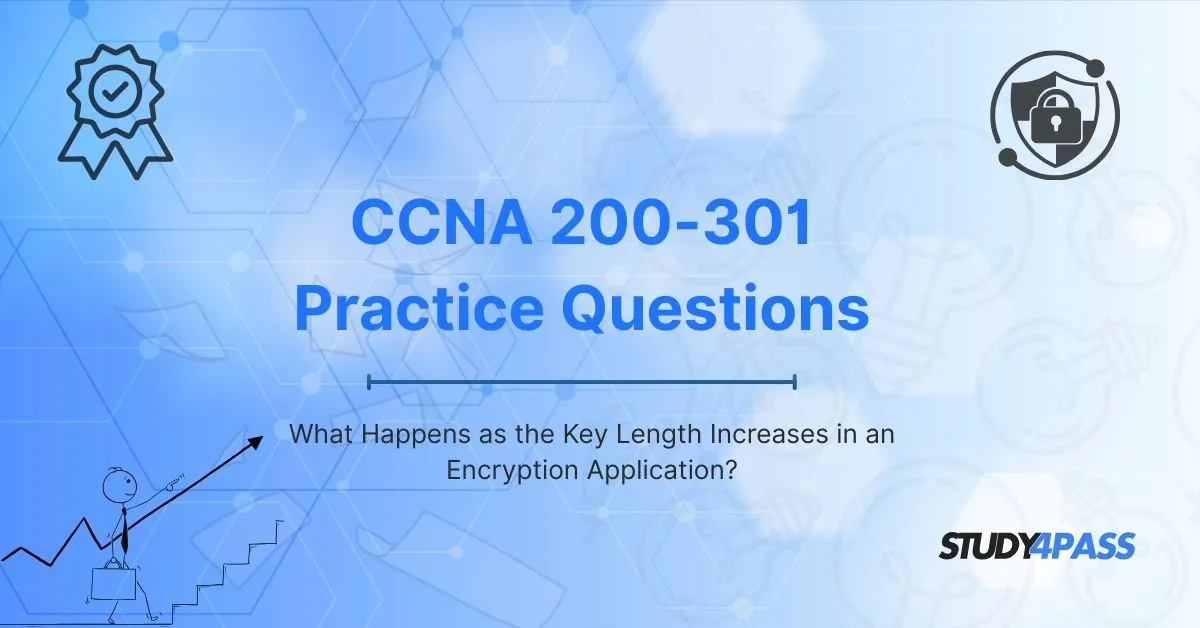Introduction To CCNA 200-301 Practice Questions
In today's digital world, cybersecurity is a top priority. Encryption plays a crucial role in securing sensitive data, whether it's personal information, financial transactions, or confidential business communications. One of the most critical aspects of encryption is key length, which directly impacts security.
If you're preparing for the CCNA 200-301 exam, understanding encryption and key lengths is essential, especially when dealing with network security protocols. At Study4Pass, we provide high-quality CCNA 200-301 Practice Questions to help you master these concepts.
In this blog, we’ll explore:
- What encryption key length means
- How increasing key length affects security
- The trade-offs between key length and performance
- Real-world applications in networking (relevant to CCNA)
- Best practices for choosing key lengths
By the end, you'll have a solid grasp of encryption key lengths and their importance in cybersecurity—knowledge that will help you in both the CCNA 200-301 exam and real-world networking scenarios.
What Is Encryption Key Length?
Encryption is the process of converting plaintext into ciphertext using an algorithm and a cryptographic key. The key length refers to the size of the key, measured in bits (e.g., 128-bit, 256-bit).
Types of Encryption Keys
1. Symmetric Encryption (e.g., AES, DES)
Uses the same key for encryption and decryption.
Common key lengths: 128-bit, 192-bit, 256-bit.
2. Asymmetric Encryption (e.g., RSA, ECC)
Uses a public key for encryption and a private key for decryption.
Common key lengths: 2048-bit, 3072-bit, 4096-bit.
The longer the key, the more secure the encryption—but there are trade-offs in performance.
How Increasing Key Length Enhances Security
1. Resistance Against Brute Force Attacks
- A brute force attack involves trying every possible key combination until the correct one is found.
- A 128-bit key has 2¹²⁸ possible combinations.
- A 256-bit key has 2²⁵⁶ possible combinations—exponentially harder to crack.
For example:
Breaking a 56-bit DES key took less than a day with modern computing power.
A 256-bit AES key would take billions of years, even with quantum computers.
2. Protection Against Advanced Cryptographic Attacks
Longer keys make encryption resistant to:
- Frequency analysis
- Side-channel attacks
- Cryptanalytic shortcuts (like mathematical weaknesses in algorithms)
3. Compliance with Security Standards
Many industries (e.g., banking, healthcare, government) mandate minimum key lengths:
- NIST recommends AES-256 for top-secret data.
- PCI-DSS requires strong encryption for payment processing.
- For CCNA 200-301, knowing these standards is crucial for configuring secure networks.
- Trade-Offs: Key Length vs. Performance
While longer keys improve security, they also impact:
1. Computational Overhead
More bits = more processing power required.
Symmetric encryption (AES) is faster than asymmetric (RSA).
Example:
AES-256 is slower than AES-128 but more secure.
RSA-4096 is more secure than RSA-2048 but requires more CPU resources.
2. Network Latency
- In VPNs (IPsec, SSL), longer keys increase handshake time.
- For real-time applications (VoIP, video streaming), balance is key.
3. Storage and Bandwidth
- Larger keys mean slightly larger encrypted files.
- Minimal impact in most cases, but critical in IoT devices with limited storage.
- Key Length in Networking (CCNA 200-301 Focus)
As a CCNA candidate, you’ll encounter encryption in:
1. VPNs (IPsec & SSL)
- IPsec uses AES (128, 192, 256-bit) for data confidentiality.
- SSL/TLS uses RSA or ECC for key exchange.
2. Wireless Security (WPA2/WPA3)
- WPA2-Personal uses AES-128.
- WPA3-Enterprise mandates AES-256 for higher security.
3. Device Management (SSH, HTTPS)
- SSH relies on RSA (2048-bit minimum) or ECC.
- HTTPS uses TLS with AES-256 for secure web traffic.
Our CCNA 200-301 practice questions cover these scenarios to help you configure and troubleshoot secure networks.
Best Practices for Choosing Key Lengths
|
Use Case |
Recommended Key Length |
|
General Data (AES) |
128-bit (good), 256-bit (best) |
|
Financial Transactions |
AES-256, RSA-3072 |
|
Government/Military |
AES-256, RSA-4096 |
|
IoT Devices |
AES-128 (if limited resources) |
- Future-Proofing with Quantum Computing
- Quantum computers could break RSA-2048 in seconds.
- Post-quantum cryptography (e.g., Lattice-based) is being developed.
- NIST recommends transitioning to longer keys (AES-256, RSA-3072+).
Conclusion
Increasing encryption key length significantly enhances security by making brute force attacks impractical and protecting against advanced threats. However, it also introduces performance trade-offs that must be balanced based on the use case.
Special Discount: Offer Valid For Limited Time “200-301 Exam Prep Practice Test”
Sample Questions for Cisco 200-301 Exam Prep Practice Tests
Actual exam question from Cisco's 200-301 Exam
Which of the following protocols operates at the OSI Transport Layer and provides reliable, connection-oriented communication?
A) IP (Internet Protocol)
B) UDP (User Datagram Protocol)
C) TCP (Transmission Control Protocol)
D) ICMP (Internet Control Message Protocol)


